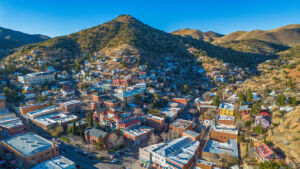While the massive pandemic of 2020 caused a massive disruption — and a temporary reprieve for rent prices — the cost of living in America is on an upward trajectory. Rest assured, this is “normal.” So, what are the cheapest and most expensive places to live in America?
READ ALSO: 25 of the best staycation deals in Arizona
Every year the Social Security Administration makes a “cost-of-living adjustment” (COLA) for retiree benefits. In 2019, there was a 2.8 percent increase in the cost of living, while 2020 was much lower at 1.6 percent. And 2021? According to a recent estimate, it could jump to as high as 4.7 percent.
With the talk of inflation and prices steadily going up at the grocery store, Americans are sweating it. Consider that meat alone is 8.6 percent more expensive than it was last year and the overall cost of groceries has risen by 3 to 5 percent every single month since the same time last year.
So it’s no surprise that nearly half of Americans (47 percent) think that the rising cost of living is the biggest threat to their financial security.
Understanding cost of living index
So what, exactly, does the cost of living index cover? Think the basics a functioning adult in America may need. That means groceries, housing, utilities, transportation, health care and miscellaneous goods and services. For our list, we’re looking at the places that are the highest percentage above the national average — and the lowest.
Cost of living takeaway
• The cost of living is highest on the coasts. No surprise here, but the cost of living is astronomical on the country’s coasts. Considering New York and San Francisco routinely show up on lists of the most expensive cities in the world, this is not breaking news. But hey, at least they’re consistent.
• The lowest cost of living in the U.S. is in the Midwest and Texas. Boasting three out of 10 slots among the 10 cities with the lowest cost of living, the Lone Star State is impressive here.
• The high spread of housing costs: The spread between the cities with the highest and lowest cost of living is dramatic, to say the least. Take the cost of housing, for starters. The best you can do in America is find housing that’s a healthy 50 percent below the national average. And the worst? You could pay an astronomical 427.9 percent higher than the majority of Americans. Ouch!
10 urban areas with the highest cost of living in the U.S.
You could probably make some solid guesses when it comes to the 10 cities with the highest cost of living across the country. But how does that cost of living break down, exactly? Is housing the biggest strain on a budget, or is it those frequent grocery runs? Read on to find out.
You can also jump ahead to see which areas have the cheapest cost of living.
10. New York (Queens), NY

- Composite Index: 148.1
- Grocery Index: 127.5
- Housing Index: 226.5
- Utilities Index: 102.5
- Transportation Index: 114.6
- Healthcare Index: 105.8
- Misc. Goods and Services Index: 120.5
Just a short hop over the East River from Manhattan, this NYC borough is on Long Island. Queens is also home to Citi Field, where the Mets play ball.
9. Oakland, CA

- Composite Index: 150.3
- Grocery Index: 127.4
- Housing Index: 215.8
- Utilities Index: 134.5
- Transportation Index: 142.8
- Healthcare Index: 122.6
- Misc. Goods and Services Index: 117.4
Oakland is to San Francisco what Queens is to Manhattan. In other words, crazy prices — just not quite as painful as their higher-profile sister city. Located on the east side of San Francisco Bay, Oakland boasts better weather than SF (more sunshine and warmer temps).
An easy BART ride from San Francisco, this creative enclave has a booming culinary scene that draws plenty from across the bay. And while housing costs are high, they’re a little less obscene than the majority of our top 10. Living in Oakland, you’ll pay 116 percent more than most Americans for housing.
8. Orange County, CA

- Composite Index: 151.0
- Grocery Index: 111.5
- Housing Index: 250.4
- Utilities Index: 91.9
- Transportation Index: 137.9
- Healthcare Index: 103.5
- Misc. Goods and Services Index: 113.2
Loving in the O.C. may cost a pretty penny, but you get plenty of bang for your buck. Think: gorgeous beaches, killer weather and you’re only an hour from Los Angeles. It’s kind of like living on permanent vacation.
Made up of metro areas including Anaheim (ahem, home of Disneyland), Santa Ana and Irvine, Orange County makes our list thanks to the high cost of living. How high? About 150 percent higher than average.
However! OC is one of only two places on our top 10 that comes in below average in at least one category. In Orange County, you’ll actually pay slightly less than average for utilities — so go ahead and crank that AC.
6 (tied). Seattle, WA

- Composite Index: 151.8
- Grocery Index: 131.4
- Housing Index: 214.7
- Utilities Index: 108.6
- Transportation Index: 140.4
- Healthcare Index: 122.8
- Misc. Goods and Services Index: 128.3
If you don’t mind a bit of rain (like 150+ rainy days per year) and you’re willing to pony up for the higher cost of everything from groceries to transportation, Seattle may just win your heart.
With one of the strongest coffee cultures across the globe, diverse culinary delights and an impressive underground music scene, there’s a lot to love about the Emerald City.
And good news, there’s plenty of room for you. After steadily growing in population over countless years, 2020 was a different story for this pricey city. Oh, and yes, we skipped No. 7 on purpose, thanks to a two-way tie for No. 6.
6 (tied). Boston, MA

- Composite Index: 151.8
- Grocery Index: 116.3
- Housing Index: 229.5
- Utilities Index: 124.8
- Transportation Index: 110.0
- Healthcare Index: 119.5
- Misc. Goods and Services Index: 126.6
While Boston is incredibly expensive, it’s got an impressive pedigree and a long history dating back to the 13 colonies in 1630. From beautiful Beacon Hill to the affluent Back Bay, Beantown lives up to its steep price tag.
Get up to speed on everything from the city’s neighborhoods to its appearance on the big screen, then decide if you’re willing to spend nearly 130 percent above average overall to live here.
5. Washington, D.C.

- Composite Index: 154.7
- Grocery Index: 112.7
- Housing Index: 257.4
- Utilities Index: 108.0
- Transportation Index: 110.0
- Healthcare Index: 91.4
- Misc. Goods and Services Index: 122.3
Beyond being the nation’s capital, D.C. is a diverse young city. Sure, there are more government workers than you can shake a ballot at, but you’ll also find some of the country’s sharpest minds in healthcare, tech and more.
Beyond the world-class museums and iconic monuments, you’ll also find a killer culinary scene with flavors that span the globe. This all comes at a steep cost, of course.
And like pretty much all of the cities in our top 10, most of your budget is going to go to housing. Be prepared to pay nearly 157 percent more than average to call the capital home, which includes nearby Arlington and Alexandria.
4. Brooklyn, NY

- Composite Index: 174.6
- Grocery Index: 125.0
- Housing Index: 319.8
- Utilities Index: 105.5
- Transportation Index: 114.0
- Healthcare Index: 104.4
- Misc. Goods and Services Index: 122.3
Oh, Brooklyn. Gone are the days when you were a hip up-and-coming hood. These days, you’re about as established as Nathan’s hot dogs. With its status comes a price tag.
Living just eight miles from the most expensive city in America may buy you a bit more space to spread out, but Brooklyn isn’t exactly a bargain. You may have to work on your budget to soak up all that street art in Bushwick and those killer Manhattan views from your neighbor’s rooftop — but hey, budgeting is practically a right of passage here.
3. Honolulu, HI

- Composite Index: 187.6
- Grocery Index: 157.9
- Housing Index: 313.1
- Utilities Index: 169.2
- Transportation Index: 141.1
- Healthcare Index: 112.3
- Misc. Goods and Services Index: 126.7
Oh hey, Honolulu! Now, this is the kind of city you expect to see on an expensive city list, right? It just screams vacation destination, so you know you’re going to pay a premium for the privilege of living here year-round. If you work in the tourism biz, you’re in the right place.
More than 10 million people visit Hawaii every year, and every one of those folks needs a place to eat and sleep. Work in the industry, and you’ll enjoy a stable career that pays off in endless mai tais, ridiculous sunsets and maybe even a salary that’s fat enough to afford this place.
2. San Francisco, CA

- Composite Index: 188.0
- Grocery Index: 130.4
- Housing Index: 342.3
- Utilities Index: 137.2
- Transportation Index: 145.0
- Healthcare Index: 122.2
- Misc. Goods and Services Index: 121.9
Despite the housing prices here going down in a somewhat dramatic fashion last year (a 27 percent slide!), San Francisco remains solidly in our No. 2 slot. Sigh. The fact is, you’re still going to pay 242 percent more than the average American for rent.
But aren’t those views of the Golden Gate Bridge worth it? And won’t the paycheck from your lucrative tech job cover your bills? What about the killer food, music and art scenes?
Get the inside scoop on living in SF, then mull it all over for a bit before you decide if living here is worth the price tag.
1. Manhattan, NY

- Composite Index: 240.6
- Grocery Index: 147.4
- Housing Index: 527.9
- Utilities Index: 102.5
- Transportation Index: 129.2
- Healthcare Index: 110.3
- Misc. Goods and Services Index: 132.4
Not unlike its West Coast rival in our number two spot, rent prices in New York have been moving in the right direction — namely, down. The big city wasn’t the best place to weather the pandemic shut down, and plenty of people left for a bit more space. As people vacated their coveted studios, rent prices dipped.
Unfortunately, a Manhattan dip is all relative. So that “bargain” your cousin’s friend is raving about will still cost you right around 428 percent more than average anywhere else in the country. But where else can you soak up this kind of culture, diversity and world-class entertainment right outside your front door?
Hey, it costs a lot to live in one of the most popular cities in the world.
10 urban areas with the cheapest cost of living in the U.S.
Are America’s 10 most expensive cities feeling a bit aspirational? We hear you. Consider the other end of the spectrum to see just how far your dollar can go if you settle somewhere in the middle of the country.
10. Pittsburg, KS

Photo source: City of Pittsburg, Kansas / Facebook
- Composite Index: 82.4
- Grocery Index: 89.8
- Housing Index: 64.1
- Utilities Index: 99.3
- Transportation Index: 91.1
- Healthcare Index: 93.5
- Misc. Goods and Services Index: 85.8
Wait, Pittsburg … Kansas? Yep, it’s not a typo. And this one doesn’t have that silent “h” at the end. Located near the Missouri state border, this Pittsburg is a bit smaller than its similarly named city in Pennsylvania but it’s got a lot to offer beyond a rock bottom cost of living (though, that definitely sweetens the deal).
Mingle with local entrepreneurs at a downtown coffee shop, catch a concert at Pittsburg State University or try your luck at the Kansas Crossing Casino. Hey, even if you lose, it’s doubtful you’ll blow your rent — which is a comfy 36 percent below average.
8 (tied). Tupelo, MS

- Composite Index: 82.3
- Grocery Index: 85.2
- Housing Index: 66.2
- Utilities Index: 86.6
- Transportation Index: 87.5
- Healthcare Index: 81.8
- Misc. Goods and Services Index: 91.6
How do you feel about the Deep South? If fried pickles, red-eye gravy and genuine friendly charm are your speed, slow down to take a look at Tupelo.
Located less than two hours from Memphis, Tupelo has one very huge claim to fame. This is the hometown of none other than Elvis Presley, and you’ll be reminded of that fact at every turn around this Mississippi town.
8 (tied). Kokomo, IN

Photo source: City of Kokomo / Facebook
- Composite Index: 82.3
- Grocery Index: 91.4
- Housing Index: 66.0
- Utilities Index: 95.3
- Transportation Index: 93.2
- Healthcare Index: 100.1
- Misc. Goods and Services Index: 82.9
You know the song, right? Well, we’ve got some news. This Indiana city isn’t actually named after a tropical isle with turquoise waters and white sandy beaches in the Florida Keys. Turns out, there’s no such place.
But there most definitely is a Kokomo, Indiana — which is home to the Kokomo Beach Aquatic Center where you can float around the lazy river or zoom down some water slides. There’s also a quaint downtown, the Kokomo Jackrabbits collegiate baseball team, band concerts in Highland Park and a whole lot more.
Better yet, everything here will cost you less than average, with the exception of healthcare which is right at the national average. Who needs sunburns and sand anyway?
6 (tied). Jackson, TN

Photo source: City of Jackson, TN / Facebook
- Composite Index: 81.2
- Grocery Index: 85.7
- Housing Index: 67.0
- Utilities Index: 97.2
- Transportation Index: 84.8
- Healthcare Index: 81.2
- Misc. Goods and Services Index: 85.6
Located between Nashville and Memphis, this charming Southern city has long been celebrated for its low cost of living. Back in 2017, Jackson made No. 6 on Fortune Magazine’s list of the Best Cities to Live in on a $100K Salary.
With housing costs 33 percent below the national average and cheaper groceries, transportation and healthcare, it’s easy to see what all the fuss is about. Did we mention that this is the birthplace of rockabilly music and the hometown of Carl Perkins?
Perhaps it’s time to consider relocating to the Volunteer State.
6 (tied). Amarillo, TX

- Composite Index: 81.2
- Grocery Index: 92.1
- Housing Index: 61.2
- Utilities Index: 95.9
- Transportation Index: 80.3
- Healthcare Index: 86.5
- Misc. Goods and Services Index: 88.4
Amarillo is one of three Lone Star State locales to crack our top 10 list for the lowest cost of living. If a slower pace of living and cowboy culture sounds like your speed, Amarillo may just be a good fit.
If you’ve ever road-tripped through the Texas panhandle, Amarillo is probably on your radar for The Big Texan, the iconic Route 66 steakhouse. Perhaps you’ve even bellied up for the 72 oz. Steak Challenge (please report back)!
With the modest cost of living around these parts, you’ll have ample dough in your pocket to splurge on steak dinners.
5. Richmond, IN

- Composite Index: 80.9
- Grocery Index: 88.5
- Housing Index: 65.9
- Utilities Index: 88.1
- Transportation Index: 100.1
- Healthcare Index: 77.9
- Misc. Goods and Services Index: 83.3
Richmond is a little slice of the Midwest at its best. Located just across the border from Ohio, not far from Dayton, Richmond residents enjoy a high quality of life and a low cost of living.
Score vintage treasures on Antique Alley, sample your way through the oh-so-sweet Chocolate Trail or check out the regional wineries and craft breweries.
And don’t be surprised to see the occasional horse and buggy. You’re in Amish Country here in Richmond, where you can expect your dollar to go far.
4. Muskogee, OK

Photo source: City of Muskogee / Facebook
- Composite Index: 79.4
- Grocery Index: 85.0
- Housing Index: 61.7
- Utilities Index: 96.7
- Transportation Index: 83.5
- Healthcare Index: 85.6
- Misc. Goods and Services Index: 84.8
Have you always wanted to call Okie from Muskogee home-like Merle Haggard? You could do a lot worse than this Midwestern gem.
Located on the Arkansas River, Muskogee is home to the Oklahoma Music Hall of Fame, a World War II submarine and a rich Native American history. Oh, and did we mention that there’s a castle? The Castle of Muskogee is a 37,000-square-foot fairground that hosts events throughout the year, from a Zombie Run to the beloved annual Renaissance Festival.
Go ahead and splurge on the turkey leg — you’re living well below the average cost of living here in Oklahoma.
3. McAllen, TX

- Composite Index: 78.4
- Grocery Index: 91.5
- Housing Index: 59.4
- Utilities Index: 105.4
- Transportation Index: 85.0
- Healthcare Index: 71.3
- Misc. Goods and Services Index: 80.4
The state of Texas is coming in hot as we approach the city with the lowest cost of living. With excellent weather, a vibrant arts and entertainment scene, and a growing population, McAllen provides a small-town atmosphere just over the Mexico border.
South Padre Island and the Gulf of Mexico are less than an hour and a half away and San Antonio is less than four hours north. You pay a hair above average for your utilities here at the southern tip of Texas, but you can expect all of your other expenses well below the American average.
2. Harlingen, TX

- Composite Index: 77.0
- Grocery Index: 79.2
- Housing Index: 57.2
- Utilities Index: 108.3
- Transportation Index: 85.4
- Healthcare Index: 78.0
- Misc. Goods and Services Index: 81.2
Clearly, there is something magical about this section of Southern Texas in the Rio Grande Valley. Harlingen not only sounds a lot like McAllen, but it’s also just 35 miles east of our No. 3 city.
Contrary to popular trends, in this case, being even closer to the ocean does not mean higher prices. You’re just 30 miles from the Gulf of Mexico and under an hour from South Padre Island here in Harlingen. You can expect plenty of small-town charm, authentic Mexican cuisine and a historic downtown with ample antiques.
And the price tag? Like McAllen, you’ll pay a touch above average for utilities, but how does rent that’s nearly 43 percent below average sound?
1. Kalamazoo, MI

- Composite Index: 76.3
- Grocery Index: 77.9
- Housing Index: 50.5
- Utilities Index: 97.8
- Transportation Index: 93.4
- Healthcare Index: 97.9
- Misc. Goods and Services Index: 83.2
Let’s be honest, who doesn’t want to say that they live in Kalamazoo? This Southern Michigan city boasts everything from a 22-mile River Valley Trail to vibrant murals around town and a massive outdoor mall that covers several city blocks. There’s plenty for nature lovers and creatives alike, and Detroit is only 140 miles away.
But let’s get down to brass tacks. What, exactly, does it mean to live in the least expensive city in America? You’ll pay half of what most Americans pay for rent, for starters, plus more than 20 percent less for groceries. Basically, all essentials will cost you less here — and you’re just an hour away from Lake Michigan.
Methodology
Cost of living information comes from The Council for Community and Economic Research and covers estimated costs as of Q1 2021.
The pricing information included in this article is used for illustrative purposes only. The data contained herein do not constitute financial advice or a pricing guarantee for any apartment.




